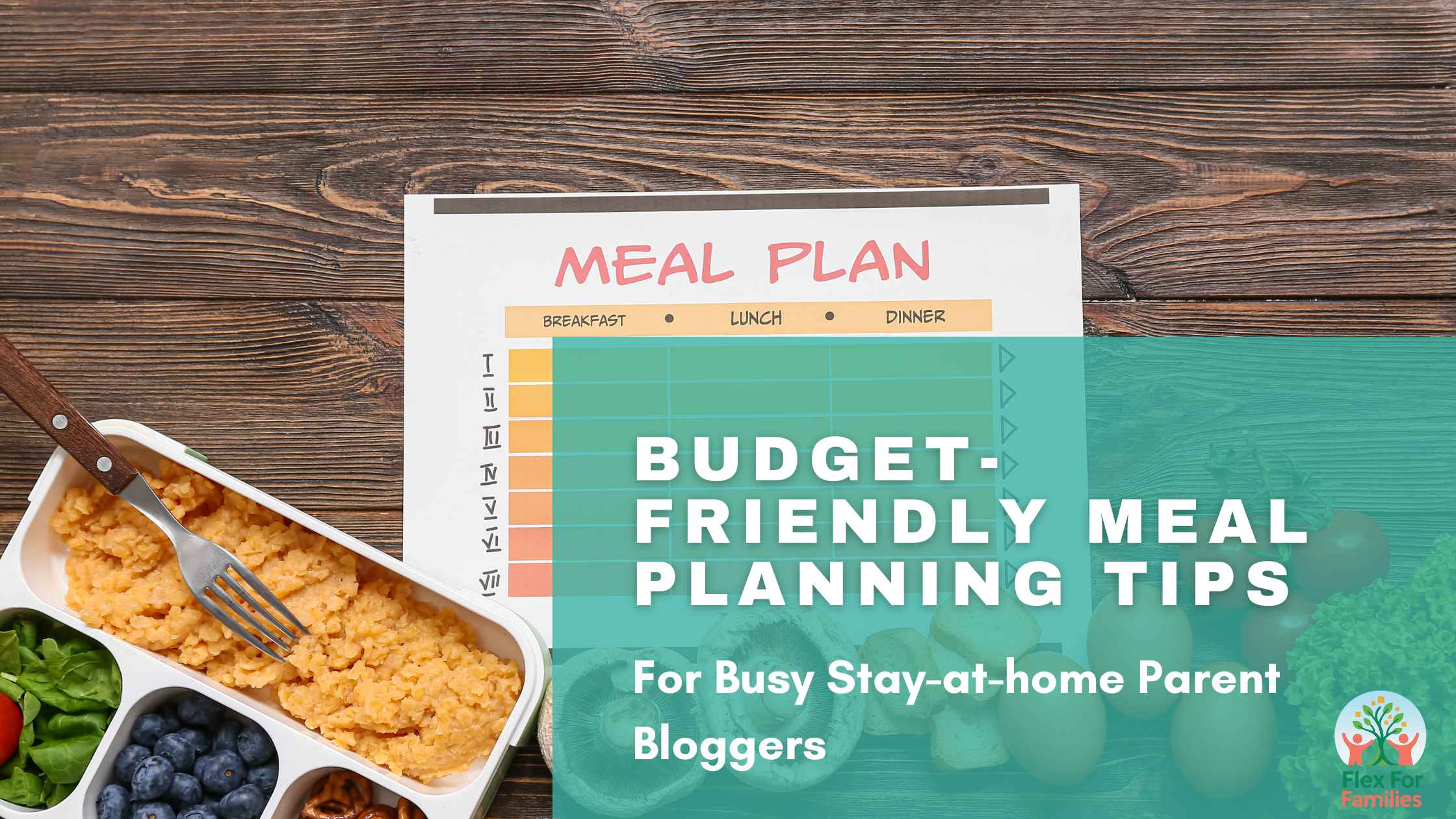Balancing blogging life and family meals can sometimes feel like playing Tetris. There are always new pieces to fit in, and the game never really slows down. Planning meals on a budget is one of the best ways to bring calm to the chaos. It helps you feed your family well, save money, and still have time to focus on your blog.

I’ve learned through trial and error that meal planning doesn’t have to be complicated or time-consuming. When you start small and find what works for your family, it becomes a habit that supports both your household and your creative work.
Why Budget Meal Planning Matters for Busy Parent Bloggers
For anyone juggling stay-at-home parenting and blogging, especially if your blog involves sharing daily routines, family advice, or budget hacks, organised, affordable meals make life a lot more manageable. Staying on top of your food budget also helps reduce stress and frees up extra cash for things like better blogging tools or family fun.
According to the USDA SNAP-Ed program, meal planning and smart grocery shopping are among the best ways to eat well while saving money. In fact, cooking at home and planning meals ahead can cut grocery costs by up to 40 per cent. I’ve definitely seen how that stacks up in my own kitchen.
Having a plan in place gives you more control over time and money, which comes in handy if you’re like me and don’t want to choose between finishing a post and making dinner from scratch every night. Plus, a little advance planning can mean fewer emergency trips for takeout or convenience food when you’re swamped with blog deadlines.
Simple Steps to Start Affordable Meal Planning

Getting started with meal planning can feel like a lot at first, but once you break it down into smaller steps, it becomes second nature. Here’s a process that keeps things simple, realistic, and easy to repeat week after week:
1. Pick a Planning Day
Choose one day each week to organise your meals. I usually do this on Sunday afternoons when things are a little calmer. Setting a regular time helps you stay consistent and avoid the midweek rush to figure out dinner.
2. Check What You Already Have
Before you even think about new recipes, look through your pantry, fridge, and freezer. You might have ingredients waiting to be used. This habit saves money, cuts waste, and often sparks creative meal ideas.
3. Choose Family Favourites
Build your plan around meals your family already enjoys. Simple, reliable recipes like pasta night, tacos, or stir fry can make everyone happy and reduce complaints at the table. Getting kids involved in picking one meal each week also helps.
4. Create a Flexible Meal Plan
I like to write a rough outline for the week, but I never make it too rigid. Life with kids and blogging doesn’t always go to plan, so leave space for leftovers, quick fixes, or the occasional pizza night.
5. Write a Grocery List that Works for You
Organise your list by category—produce, pantry, dairy, frozen—to make shopping quicker. Having a clear list keeps you focused and reduces impulse buys that sneak up on your budget.
Over time, you’ll start to notice patterns in what works for your family. I keep a simple “meal rotation list” on my phone with 15 or 20 of our favourite dinners. Each week, I mix and match from that list, which saves time and removes the mental load of deciding what to make.
Meal Prepping: Save Time Without the Fuss

Meal prepping doesn’t need to mean spending your entire Sunday cooking. For me, it’s about creating simple “building blocks” that make weekday meals quicker to pull together. A few minutes of prep here and there add up to big-time savings later.
Prep Your Grains
Cooking big batches of rice, pasta, or quinoa ahead of time makes it easy to mix and match meals during the week. Store portions in containers so you can grab what you need for a quick stir fry, salad, or wrap.
Batch Your Proteins
Roast a tray of chicken breasts, bake tofu, or cook a pot of beans. These can be used in tacos, pasta, rice bowls, or sandwiches. When time is short, a store-bought rotisserie chicken can also stretch across several meals.
Chop Veggies in Advance
Spend a few minutes slicing carrots, cucumbers, and peppers at once. Store them in airtight containers for easy snacks or lunchbox fillers. Having ready-to-go produce makes it easier to grab something healthy when you’re short on time.
Mix Simple Sauces and Dressings
A homemade vinaigrette, peanut sauce, or yoghurt dressing can make basic meals feel brand new. I like to keep one or two in the fridge to add quick flavour to leftovers or salads.
Prepping this way saves me from that “what’s for dinner?” panic on busy blogging days. It also gives me more time to focus on writing, editing, and connecting with readers while still serving home-cooked meals that my family actually enjoys.
Strategies to Stretch Your Grocery Budget

Feeding a family on a budget takes creativity, but once you build a few habits, it becomes second nature. I’ve tested a lot of ideas over the years, and these are the ones that consistently help me save money without sacrificing quality.
Shop Sales and Use Coupons
Before making your grocery list, take a quick look at store flyers or coupon apps. I often plan meals around what’s on sale instead of building my list first. Swapping a pricey ingredient for a discounted one can make a big difference over time.
Stick to Staples
Simple pantry items like rice, dried beans, oats, and canned tomatoes go a long way. They’re filling, inexpensive, and easy to stretch into multiple meals. I like keeping them stocked so I can make dinner even when the fridge looks empty.
Limit Processed Foods
Packaged snacks and frozen convenience meals might save time, but they’re usually more expensive per serving. Whole foods often cost less and keep everyone full longer. I try to prep our own snacks—like muffins or popcorn—whenever I can.
Buy in Bulk When You Can
Buying large quantities of staples such as pasta, grains, or beans often costs less in the long run. I store them in airtight containers to keep them fresh and avoid extra trips to the store.
Shop Local When Possible
Local markets and discount stores can surprise you with great prices, especially for fresh produce or seasonal goods. Some farmers’ markets even offer end-of-day discounts that fit tight budgets nicely.
Every small saving adds up. The more intentional you are with what you buy, the easier it becomes to feed your family well without breaking the budget. And that extra bit you save might just go toward your next blogging tool, online course, or a well-deserved family treat.
Timesaving Kitchen Tools and Apps

When life gets busy, the right kitchen tools and apps can make all the difference. They help you spend less time cooking and more time doing what matters most—whether that’s blogging, spending time with your kids, or finally sitting down with a cup of tea.
Slow Cooker or Instant Pot
These are lifesavers on busy days. You can toss in ingredients in the morning, then let dinner cook itself while you focus on writing or editing. Coming back to a ready meal at the end of the day feels like a small victory.
Meal Planning Apps
Apps such as Mealime, Plan to Eat, or Paprika take the guesswork out of meal planning. They store your recipes, create grocery lists, and help you plan meals around your week. Everything stays organised, and it’s one less thing to juggle mentally.
Quality Storage Containers
Stackable containers make it easier to keep your fridge and freezer neat. You can prep lunches or store leftovers for the next day’s meals. Clear containers also make it simple to spot what’s ready to grab when time is tight.
Keep a Well-Stocked Spice Drawer
Having your favourite spices within reach can completely transform a basic meal. It’s a small thing, but it keeps cooking fun and flavorful. I also keep backup basics like flour, rice, and baking supplies to avoid last-minute store runs.
The goal isn’t to fill your kitchen with gadgets—it’s to find tools that make everyday cooking simpler and more enjoyable. Anything that saves even 15 minutes can help you reclaim that time for your blog or a well-earned family break.
Common Challenges and How to Work Around Them

Even the best meal plans can hit a few bumps. Between picky eaters, last-minute surprises, and burnout, it’s normal to feel like you’re constantly adjusting. Here are a few challenges I’ve faced (and what’s helped me handle them).
Picky Eaters
Finding something everyone enjoys can be tricky. I try to include at least one familiar food in every meal so no one feels left out. Getting the kids involved in planning or prepping helps, too. When they help pick veggies or toppings, they’re more likely to eat them.
Last-Minute Plan Changes
Parent life is full of surprises—school events, playdates, sick days, or just plain exhaustion. I keep a few go-to meals ready for backup, like scrambled eggs with toast or a quick soup made from canned beans and frozen veggies. It’s nice to know I have a fallback plan when the day runs off track.
Burnout in the Kitchen
Sometimes the idea of cooking again is just too much. That’s when freezer-friendly meals save me. I double up on recipes like chilli, stew, or enchiladas so I can freeze half for a night when I need a break. Even one “heat-and-eat” meal can make a rough week smoother.
Avoiding Food Waste
Leftovers can pile up fast. I plan one “clean-out night” each week to use up what’s left in the fridge. Mixing odds and ends into wraps, soups, or stir-fries keeps things interesting and saves money. I also freeze small portions for quick lunches later on.
Meal planning isn’t about being perfect. It’s about building small, flexible habits that work for your family, even on the busiest weeks.
Creative Recipe Ideas for Tight Weeks

Even when the grocery budget feels tight, it’s still possible to keep meals fun and satisfying. I’ve found that the simplest recipes are often the most loved, especially when you can mix and match ingredients based on what you already have.
One-Pot Pasta
This is a go-to for busy nights. Toss your pasta, veggies, and protein of choice into a single pot with a bit of broth or sauce. Everything cooks together, which means fewer dishes and more flavour in every bite.
Rice Bowls
Rice bowls are endlessly customisable and perfect for using leftovers. Layer rice, beans, roasted veggies, or chopped chicken, then add toppings like salsa, avocado, or cheese. Everyone can build their own version, which keeps dinner fun and flexible.
Sheet Pan Dinners
When time is short, I throw whatever veggies and protein I have on a baking sheet, drizzle with olive oil, and season with herbs. Pop it in the oven, and dinner’s done with almost no cleanup.
Breakfast for Dinner
Some nights, pancakes or scrambled eggs are exactly what everyone needs. Add fruit, yoghurt, or toast on the side, and you’ve got a quick, affordable meal that still feels special.
Soup and Sandwich Night
This combo stretches your ingredients and warms everyone up. A simple soup made from broth, canned beans, and leftover veggies pairs perfectly with grilled cheese or wraps.
The best part about these recipes is that they’re flexible. You can swap ingredients, adjust portions, or use what’s already in your pantry. Cooking this way keeps me from feeling boxed in and reminds me that “good enough” meals are still nourishing and full of care.
Frequently Asked Questions
How do you handle unplanned schedule changes with meal planning?
I always build one “flex night” into the plan. It’s a free evening where we either use up leftovers or make something quick. If the week runs smoothly, I just move that meal to another day or take the night off from cooking altogether.
What are some filling and cheap snack ideas for kids?
We rely on homemade popcorn, sliced apples with peanut butter, veggie sticks with hummus, and simple muffins. These snacks take little prep and cost far less than store-bought options.
How do you add variety without spending more?
I switch up how we use the same ingredients. A roasted chicken might become sandwiches one night, stir fry the next, and soup at the end of the week. Using new spices or sauces also keeps repeat meals interesting.
What if I struggle to stay consistent with meal planning?
Start small. Plan just three dinners a week at first. As it becomes routine, you can expand your plan. It’s better to stick with a small system that works than to overcommit and feel frustrated.
Final Thoughts
Budget-friendly meal planning is one of those habits that quietly transforms family life. It saves money, reduces stress, and frees up time for the things that really matter—like building your blog, playing with your kids, or simply enjoying a calm evening at home.
You don’t need to follow a strict plan or cook gourmet meals. Focus on simple steps that make your week smoother, and celebrate every small win along the way. With a bit of planning and creativity, you can nourish your family and your blogging goals at the same time.
💬 Let’s Chat
Meal planning looks a little different in every home, and that’s what makes it so inspiring. I’d love to hear from you — how do you make mealtime work around your family’s routine and your blogging schedule?
Maybe you batch cook on weekends. Maybe you’ve mastered the art of creative leftovers. Or maybe you’re just starting to plan meals for the first time and finding what fits your flow.
Share your tips or favourite budget-friendly recipe ideas in the comments. Your experience could be exactly what another busy parent blogger needs to hear today.




